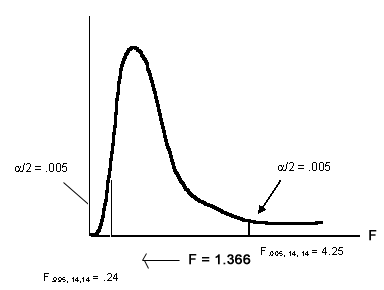|
Manual Solutions:
Step 1:
This is a two -tailed test. The null and alternative hypothesis
are:
Ho:
Ha: 
Step 2:
The appropriate test statistic is:

Step 3:
Alpha of .01, since test is two-tailed divide it by 2, alpha is
= .005
Step 4:
The degrees of freedom are as follows:

The critical F value obtained from table A.7 is:

The decision rule is to reject the null hypothesis if the observed
value of F is greater than 4.25 or less than .24.
Step 5:
The following sample variances are computed
from the data:

Step 6:
The calculated F value is:

Step 7:
The calculated value of F = 1.366 is less
than the upper tail critical value of 4.25, we therefore fail to
reject the null hypothesis.
Step 8:
The age variance of male working in federal U.S. govt. is greater
than the variance of male working in nonfederal U.S. government.
For further examination, the company may get more information about
this result that younger males are likely to work in nonfederal
than federal U.S. governments.
The following graph shows the critical
and calculated F values:

Back to: Finals Main Page
|





